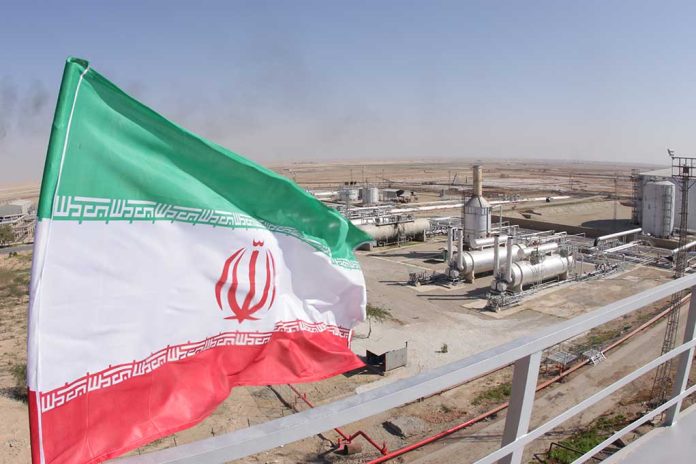
Oil prices surge over 7% as Israel-Iran conflict threatens a fifth of the world’s oil supply through the Strait of Hormuz.
Key Takeaways
- Brent crude futures jumped by $2.37 (3.2%) to $76.60 per barrel while US West Texas Intermediate increased by $2.39 (3.3%) to $75.37 following renewed military confrontations.
- The Strait of Hormuz, now at risk of disruption, handles approximately 20% of global oil consumption—roughly 18-19 million barrels daily.
- Iran produces 3.3 million barrels per day and exports over 2 million barrels of oil and fuel, creating significant supply concerns amid the escalating conflict.
- OPEC and allies including Russia have spare capacity roughly equivalent to Iran’s output, potentially mitigating some supply disruptions.
- Iran has rejected ceasefire negotiations while under Israeli attack, complicating diplomatic efforts including those at the upcoming G7 summit in Canada.
Military Strikes Drive Oil Markets Higher
Global oil markets experienced significant price surges on Monday as Israel and Iran exchanged military strikes, creating fears of broader regional conflict that could disrupt crucial energy supply routes. Brent crude futures settled 7% higher on Friday, reaching their highest levels since January, and continued climbing with an additional 3.2% increase to $76.60 per barrel. US West Texas Intermediate crude similarly jumped 3.3% to $75.37. These sharp price movements reflect growing anxiety among energy traders about potential supply disruptions in one of the world’s most critical oil-producing regions.
The exchange of military strikes has resulted in civilian casualties on both sides, intensifying concerns that the conflict could spread throughout the Middle East. Market analysts note that oil prices are particularly sensitive to developments in the Israel-Iran situation due to the strategic importance of the region’s shipping lanes and production facilities. The conflict threatens to disrupt oil shipments through the Strait of Hormuz, a narrow waterway that serves as the primary transit route for Middle Eastern oil exports to global markets.
Strait of Hormuz Vulnerability Creates Global Supply Risks
The Strait of Hormuz represents a critical choke point in global oil markets, handling approximately one-fifth of the world’s total oil consumption. With 18 to 19 million barrels transiting through this narrow passage daily, any disruption could have immediate and severe impacts on global energy supplies and prices. Iran’s strategic position along the strait gives it significant leverage in the ongoing conflict, as even the threat of disruption can send shock waves through energy markets worldwide.
Iran’s oil production capacity of 3.3 million barrels per day, with exports exceeding 2 million barrels daily, represents a significant portion of global supply that could be affected by the conflict. While OPEC and its allies, including Russia, maintain spare production capacity roughly equivalent to Iran’s output, activating this reserve capacity would require coordination and time. The uncertainty surrounding potential disruptions has created a risk premium in oil prices that could persist as long as tensions remain elevated.
Diplomatic Efforts Face Significant Challenges
Diplomatic initiatives to resolve the conflict face substantial obstacles as regional tensions continue to escalate. German Chancellor Friedrich Merz expressed hope that the upcoming Group of Seven leaders meeting in Canada might contribute to de-escalation efforts. However, Iranian officials have communicated to mediators Qatar and Oman that they are unwilling to negotiate a ceasefire while under Israeli attack, creating a diplomatic impasse that complicates resolution efforts.
U.S. President Trump on Sunday said that Israel and Iran can broker a ceasefire, but added that “sometimes countries have to fight it out first.”
The economic implications of the conflict extend beyond immediate oil price increases. Analysts warn that a prolonged period of elevated oil prices could contribute to inflationary pressures globally, potentially complicating economic recovery efforts and central bank policies. For American consumers, the conflict threatens to reverse recent trends of declining gasoline prices, potentially adding pressure to household budgets already strained by persistent inflation in other sectors. The Biden administration’s energy policies, which have restricted domestic production, leave the U.S. more vulnerable to these international supply disruptions.
Market Outlook Remains Volatile
The oil market outlook remains highly uncertain as traders balance immediate supply concerns against potential diplomatic breakthroughs. Friday’s price surge represented the largest single-day increase in oil prices in approximately three years, demonstrating the market’s sensitivity to developments in the conflict. Analysts caution that volatility will likely persist as long as military exchanges continue, with prices reacting sharply to news of attacks, diplomatic initiatives, or changes in shipping patterns through vulnerable Middle Eastern waterways.
For global energy markets, the Israel-Iran conflict represents a significant test of resilience and adaptability. While strategic petroleum reserves provide some buffer against short-term disruptions, a prolonged conflict affecting major shipping lanes could strain the global energy system. The situation highlights America’s need to prioritize energy independence through increased domestic production rather than relying on volatile international markets. President Trump’s earlier policies that emphasized American energy dominance stand in stark contrast to current approaches that have left the country more exposed to international energy price shocks.



